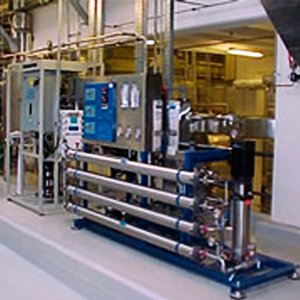Technologies > Ionic Exchange
Basics:
It is a process in which certain materials are able to exchange water ions.
The materials are polymers (macromolecules), with active terminal functional groups, where exchange reaction produces.
For water demineralization the most commonly used is the polystyrene intercrossed with divinylbenzene. The most frequent functional groups are the sulfonic and amino in cationic and anionic exchange resins. The materials are small spheres (0.8 to 0.5 mm diameter) and are disposed in column shape in tanks to allow water to pass at the appropriate rate for the process.
According to the following reactions it is a reversible process:
R-OH + Cl- R-Cl + OH-
RH + Na+ R-Na + H+
Where: R is the functional group
Process different steps:
1- Ions transport till material surface (design rate)
2- Diffusion through macrostructure (resin type)
3- Exchange chemical reaction (mass action law, ion net charge)
Desired ion fixation and settled ion displacement.
4- Displacement ions sweeping (design rate).
Process commanding step is ion transport (step 2) till becoming to the functional group. The process continues till resin draining, after which it regenerates with appropriate concentrate solutions for each application case. The process occurs in the reverse way of the exchange process.
Water treatment applications:
The most frequent ionic exchange processes in water treatment are:
Softening
Demineralization
In the softening, ions exchanged are those that increase water hardness and scale promoter like calcium, magnesium, barium, strontium and iron.
It is used sodium cycle strong cationic resins type and the reaction is the following:
2R-Na + Ca++ R2Ca + 2Na+
In water demineralization it is search anions and cations removal, according:
a) R-OH + Cl- RCl + OH-
b) RH + Na+ R-Na + H+
c) OH- + H+ H2O
Regeneration Process:
Chemical products used for the regeneration are:
• For softeners, sodium chloride
• In demineralization, strong acids like hydrochloric or sulfuric for cationic resin and sodium hydroxide for anionic resin.
Main resin problems:
a. Polluting:
The resin is covered by suspended material like particles and colloidal shape, just organic as well as inorganic. In this conditions exchange capacity decreases because ion transport to active place is stopped.
Depending on the polluting, different types of resins may be recovered by wash back and/or chemical washes.
b. Oxidation:
By free chlorine and other oxidizer of polymer crossed joints degrading and decreasing exchange capacity. It cannot be recovered.
c. Microbiologic pollution:
By high microorganism concentration presence in feeding water or grant and extention of stops. Specific product sanitizations may be done.
d. Contrition:
Resin size decrease by rubbing because of oblong use or back wash high rate, loosing the bed. When the capacity decreases the bed has to be changed.
